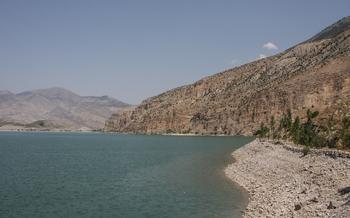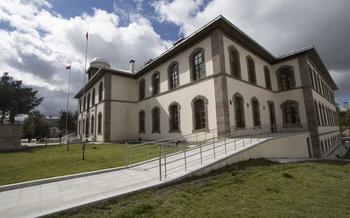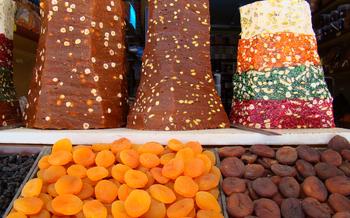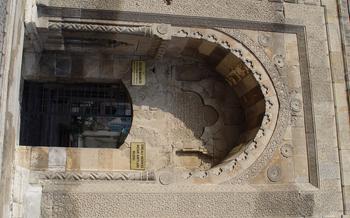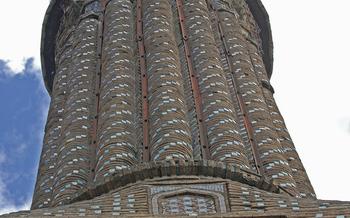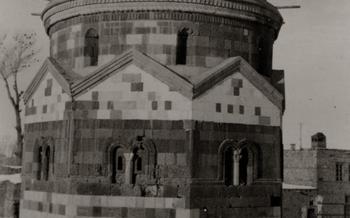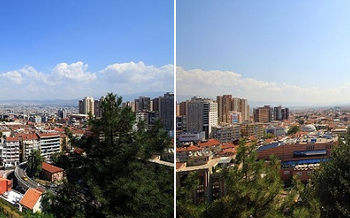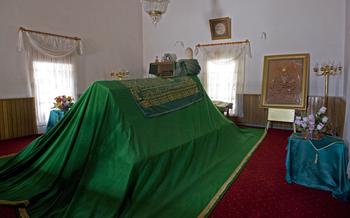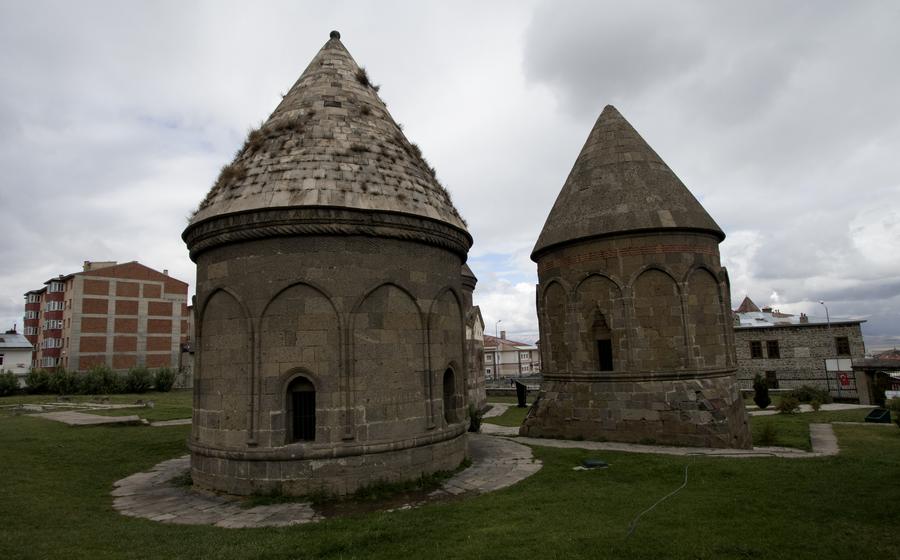
Three Tombs (Üç Kümbetler)
- History of the Three Tombs:
- Location and Accessibility
- Architectural Highlights
- Historical Context
- Visiting the Three Tombs
- Photography Tips
- Tips for a Memorable Visit
- Exploring Erzurum's History
- Culinary Delights of Erzurum
- Souvenirs and Handicrafts
- Accommodation Options
- Getting Around Erzurum
- Planning Your Itinerary
- Beyond Erzurum
- Insider Tip: Unveiling Erzurum's Hidden Gems
History of the Three Tombs:
The Three Tombs (Üç Kümbetler) in Erzurum, Turkey, stand as architectural marvels that date back to the 13th century. Constructed during the reign of the Seljuk Empire, these magnificent structures were commissioned by three prominent rulers: Sultan Alaeddin Keykubad I, his son and successor Sultan Gıyaseddin Keyhüsrev II, and the latter's wife, Sultan Hatun.
Each tomb showcases a unique architectural style, reflecting the grandeur and artistry of the Seljuk era. Intricate carvings and inscriptions adorn their exteriors, narrating tales of history and power. The tombs' interiors are equally awe-inspiring, featuring intricate designs, vaulted ceilings, and beautifully crafted mihrabs.
Beyond their architectural significance, the Three Tombs hold immense historical value. They represent the Seljuk Empire's influence on Anatolian architecture and serve as a testament to Erzurum's role as a regional center during that period. These mausoleums have stood the test of time, bearing witness to centuries of history and embodying the enduring legacy of the Seljuk dynasty.
Location and Accessibility
The Three Tombs are situated in the Yakutiye district of Erzurum, Turkey, within the vicinity of the historic Erzurum Citadel. This ancient fortress, perched atop a hill, offers panoramic views of the city and the surrounding landscape. To reach the tombs from the city center, visitors can opt for a leisurely stroll or utilize public transportation, which provides convenient access to the site.
The Erzurum Airport (ERZ), approximately 10 kilometers from the city center, serves as the gateway for air travelers. From the airport, visitors can take a taxi or arrange for a private transfer to reach the Three Tombs directly. Alternatively, Erzurum's central bus station, located in the Yenişehir district, offers connections to various cities across Turkey. From the bus station, visitors can transfer to local buses or taxis to reach the tombs.
For those seeking a more immersive experience, guided tours are available, offering insights into the history, architecture, and cultural significance of the Three Tombs. These tours typically depart from the city center and provide transportation to and from the site. Alternatively, visitors can choose to explore the tombs independently, allowing for a more personalized experience.
Architectural Highlights
The Three Tombs of Erzurum stand as testaments to the architectural prowess of the Seljuk Empire. Each tomb boasts distinctive features that set it apart from the others. The first tomb, also known as the Emir Saltuk Tomb, captivates with its intricate carvings and inscriptions adorning its exterior. The entrance portal is adorned with a stunning array of geometric patterns and Kufic script, showcasing the Seljuk mastery of decorative arts.
The second tomb, known as the Emir Ahmet Shah Tomb, exhibits a more austere exterior, featuring a plain cylindrical body. However, its interior reveals a hidden treasure - a magnificent painted ceiling that depicts celestial bodies and constellations. These vibrant paintings offer a glimpse into the Seljuk understanding of astronomy and their fascination with the cosmos.
The third tomb, known as the Emir Yakub Shah Tomb, strikes a balance between the opulence of the first tomb and the simplicity of the second. Its exterior features elegant carvings and inscriptions, while the interior showcases a beautifully adorned mihrab, the prayer niche indicating the direction of Mecca.
Collectively, the Three Tombs showcase the diverse architectural styles and decorative elements that characterized the Seljuk Empire. Their intricate carvings, inscriptions, and painted ceilings offer a fascinating glimpse into the artistic and cultural achievements of this influential dynasty.
Historical Context
The Seljuk Empire, a powerful dynasty of Turkic origin, ruled over a vast territory stretching from Central Asia to Anatolia during the 11th to 13th centuries. Their reign marked a significant period in Turkish history, leaving a lasting impact on the region's architectural landscape. The Seljuk Turks were renowned for their architectural prowess, blending Islamic traditions with local Anatolian influences to create a distinctive style.
During the Seljuk era, Erzurum emerged as a prominent regional center, strategically located along trade routes and serving as a gateway to the Caucasus region. The city's strategic importance attracted the attention of Seljuk rulers, who commissioned the construction of several notable structures, including the Three Tombs. These tombs stand as testaments to the Seljuk Empire's architectural achievements and their influence on Anatolian history.
The political and cultural significance of the Three Tombs cannot be overstated. They served as mausoleums for prominent Seljuk figures, including emirs and military commanders, who played a crucial role in expanding and consolidating the empire. The tombs also held religious significance, embodying the Seljuks' deep-rooted Islamic beliefs and their commitment to honoring their deceased leaders.
Throughout history, the Three Tombs have witnessed countless historical events and been associated with various figures who shaped the course of Turkish history. Their enduring presence serves as a reminder of the Seljuk Empire's legacy and its lasting impact on the cultural and architectural heritage of Turkey.
Visiting the Three Tombs
The Three Tombs are open to visitors daily, offering a glimpse into their historical significance and architectural beauty. Admission fees are nominal, allowing travelers to explore the site at an affordable cost. Visitors should dress respectfully when visiting the tombs, as they are considered sacred religious sites. Appropriate attire includes covering shoulders and knees, and removing shoes upon entering the tombs.
The Three Tombs are accessible to visitors with disabilities or special needs. Ramps and designated parking spaces are available, making it easy for all visitors to experience the site. The site's well-maintained paths and open spaces allow for comfortable navigation, ensuring an enjoyable visit for everyone.
Photography enthusiasts will find the Three Tombs a treasure trove of opportunities to capture stunning images. The intricate carvings, decorative elements, and architectural details provide a rich canvas for creative photography. Visitors can take advantage of the natural lighting conditions, particularly during sunrise and sunset, to capture the tombs' beauty in its full glory.
Photography Tips
Capturing the Three Tombs' architectural grandeur requires careful consideration of camera settings and techniques. Utilizing a tripod for stability and avoiding harsh midday light ensures sharp, well-exposed images. Experiment with different angles to showcase the tombs' unique perspectives and incorporate surrounding elements like the sky and landscape for a dynamic composition. Focus on intricate details and textures, using a shallow depth of field to draw attention to specific features. Don't forget to explore different vantage points, including elevated positions for panoramic shots. Patience and experimentation are key to capturing stunning photographs that truly convey the essence of these magnificent structures.
Tips for a Memorable Visit
Plan your visit during the shoulder season (May-June or September-October) to enjoy pleasant weather without the crowds of the peak season.
Combine your visit to the Three Tombs with other nearby attractions such as the Erzurum Castle, the Ulu Mosque, or the Yakutiye Medrese to get a comprehensive understanding of the city's history and culture.
Be respectful of the religious significance of the tombs and dress appropriately. Visitors should avoid wearing shorts or revealing clothing.
Take your time to explore the tombs and their surroundings. Admire the intricate carvings, inscriptions, and decorative elements that adorn each tomb.
Capture the beauty of the tombs with your camera, but be mindful of other visitors and avoid using flash photography inside the tombs.
Exploring Erzurum's History
Erzurum's rich history is not limited to the Three Tombs. The city boasts a treasure trove of historical sites and landmarks that offer a glimpse into its past. Visitors can delve deeper into Erzurum's heritage by exploring the following attractions:
-
Erzurum Castle: A majestic fortress that stands atop a hill overlooking the city. The castle dates back to the Byzantine era and has witnessed numerous battles and conquests throughout history.
-
Yakutiye Medresesi: A magnificent Islamic seminary built in the 14th century. The medrese is adorned with intricate carvings and calligraphy, showcasing the architectural prowess of the Seljuk era.
-
Ulu Cami: One of the oldest mosques in Erzurum, dating back to the 12th century. The mosque's unique architecture blends Seljuk and Ottoman styles, creating a visually stunning masterpiece.
-
Erzurum Archaeology Museum: Home to a vast collection of artifacts from various periods of Erzurum's history. Visitors can learn about the city's ancient civilizations, including the Urartians, Romans, and Byzantines.
-
Erzurum Ethnography Museum: This museum showcases the traditional lifestyle, customs, and handicrafts of the Erzurum region. Visitors can gain insights into the rich cultural heritage of the local people.
To fully immerse themselves in Erzurum's history, visitors can embark on a historical walking tour or guided excursion. These tours provide expert insights into the city's landmarks and offer a deeper understanding of its past.
Culinary Delights of Erzurum
Erzurum's cuisine boasts a tantalizing array of flavors that reflect the city's rich history and cultural influences. One must-try dish is cağ kebabı, a unique preparation of lamb skewers grilled over an open fire and served with roasted tomatoes and peppers. The meat is tender and succulent, infused with a smoky aroma that will tantalize your taste buds.
For a hearty and comforting meal, indulge in Erzurum mantısı, delicate dumplings filled with ground beef or lamb and topped with a tangy yogurt sauce, garlic, and paprika. The dumplings are known for their distinctive shape and are a beloved local specialty.
Vegetarians can delight in karalahana çorbası, a hearty soup made with black cabbage, beans, and spices, offering a warm and flavorful experience. Kuru fasulye, a traditional Turkish dish of stewed white beans, is another popular choice, often served with rice or bulgur.
To satisfy your sweet tooth, don't miss kadayıf dolması, crispy shredded pastry filled with walnuts and sweetened with syrup. Erzurum tulum peyniri, a local cheese aged in goatskin bags, is a unique delicacy with a sharp and tangy flavor.
Whether you prefer to savor these culinary delights in a cozy restaurant, sample street food from local vendors, or take a cooking class to learn the secrets of Erzurum cuisine, your taste buds are in for a delightful journey.
Souvenirs and Handicrafts
Erzurum is a treasure trove of unique souvenirs and handicrafts that reflect its rich cultural heritage. Visitors can find an array of handwoven carpets, kilims, and textiles, each adorned with intricate patterns and vibrant colors. These traditional crafts are a testament to the skill and artistry of local artisans.
In the bustling markets and shops of Erzurum, visitors can discover an array of handmade copperware, pottery, and jewelry. These items are often adorned with intricate designs and motifs inspired by Seljuk and Ottoman art. Visitors can also find unique souvenirs made from wood, leather, and semi-precious stones, each telling a story of Erzurum's craftsmanship.
When shopping for souvenirs in Erzurum, it's essential to support local artisans and craftsmen by purchasing handmade goods. Bargaining is a common practice in local markets, and visitors can often negotiate prices to get the best deals. Remember to be respectful and patient when engaging in bargaining, as it's a way for locals to maintain their livelihoods.
By bringing back a piece of Erzurum's handicrafts, visitors can not only cherish a memento of their travels but also contribute to the preservation of traditional arts and crafts that are an integral part of the city's identity.
Accommodation Options
Erzurum offers a range of accommodation options to suit different budgets and preferences. From budget-friendly guesthouses and hostels to comfortable hotels, visitors can find a place to stay that meets their needs. For those seeking a luxurious experience, there are several upscale hotels offering modern amenities and stunning views of the city or the surrounding mountains.
For budget-conscious travelers, there are numerous guesthouses and hostels located within walking distance of the city center. These accommodations offer basic but comfortable rooms at affordable prices. Some popular options include Erzurum Backpackers Hostel, Grand Hostel Erzurum, and Dorm 41 Erzurum.
Mid-range hotels provide a good balance of comfort and value. These hotels typically offer private rooms with en-suite bathrooms, as well as amenities such as free Wi-Fi, breakfast, and laundry service. Recommended mid-range hotels in Erzurum include Ramada Plaza Erzurum, Dedeman Erzurum, and Polat Erzurum Resort & Convention Center.
For those seeking a luxurious stay, Erzurum offers several upscale hotels with world-class amenities and breathtaking views. These hotels often feature spacious rooms, fine dining restaurants, and state-of-the-art fitness centers. Top luxury hotels in Erzurum include Palandöken Ski & Congress Hotel, Divan Erzurum, and Conrad Erzurum.
When choosing a hotel in Erzurum, it's important to consider the location, amenities, and budget. For those interested in exploring the city's historical sites, it's best to choose a hotel in the city center. Those who prefer to be close to the ski slopes should opt for a hotel in the Palandöken Ski Resort area.
To ensure a comfortable stay, it's advisable to book accommodations in advance, especially during peak tourist seasons such as winter and summer. Online booking platforms like Booking.com and Expedia offer a wide range of options and allow travelers to compare prices and amenities.
Getting Around Erzurum
Navigating Erzurum is a breeze, offering a range of transportation options to suit every traveler's needs. For those who prefer public transportation, buses and taxis are readily available throughout the city. Buses run on designated routes, connecting major attractions and neighborhoods. Taxis, while slightly more expensive, provide a convenient door-to-door service. Renting a car is an excellent choice for exploring Erzurum at your own pace and venturing beyond the city limits. Several car rental agencies are located in the city center, offering a variety of vehicles to choose from. If you're looking for a more immersive experience, consider hiring a driver. Local drivers can provide valuable insights into the city's history and culture and take you to hidden gems that may not be easily accessible on your own. For those who enjoy the freedom of exploring on foot, Erzurum is a pedestrian-friendly city. Many attractions are located within walking distance of each other, allowing you to discover the city's charm and hidden corners at your own pace. Whichever mode of transportation you choose, Erzurum is a city that's easy to navigate and explore. Just remember to take necessary safety precautions, such as wearing a seatbelt when traveling by car or taxi and being aware of your surroundings when exploring on foot.
Planning Your Itinerary
When planning your itinerary for exploring Erzurum, consider the following tips to make the most of your visit:
One-Day Itinerary: If you have limited time, allocate the morning to visit the Three Tombs, appreciating their architectural details and historical significance. Afterwards, explore the city center, including the Grand Mosque and Üç Kümbetler Madrasah. Spend the evening strolling through the vibrant streets, sampling local delicacies from food stalls or cozy restaurants.
Multiple-Day Itinerary: For a more comprehensive experience, spread your exploration over two or three days. Dedicate one day to the Three Tombs and other historical sites, such as the Erzurum Castle and Yakutiye Madrasah. On another day, venture further afield to nearby attractions like Tortum Waterfall or Lake Çıldır. If time permits, consider taking a day trip to Kars, known for its well-preserved medieval Armenian churches.
Personalize Your Experience: Prioritize attractions that align with your interests. If history captivates you, delve deeper into Erzurum's past at the Erzurum Museum or join a guided historical walking tour. Nature enthusiasts can explore the scenic Tortum Valley, hike to the summit of Mount Palandöken, or embark on a birdwatching expedition at Lake Çıldır.
Manage Your Time: Allocate sufficient time for each activity, allowing for leisurely exploration and savoring the moment. Avoid packing your itinerary too tightly, as spontaneity and flexibility can lead to unexpected discoveries. Remember to balance sightseeing with relaxation, taking breaks to enjoy the city's vibrant atmosphere and indulge in local culinary delights.
Beyond Erzurum
Erzurum serves as a gateway to a wealth of captivating destinations in the region. Embark on a day trip to Tortum Lake, a picturesque natural wonder renowned for its mesmerizing turquoise waters and serene ambiance. Explore the historic city of Kars, home to the well-preserved Kars Castle and the captivating Ani Ruins, a UNESCO World Heritage Site. For a unique cultural experience, visit the Ispir Yedigöller National Park, where seven stunning lakes cascade down a mountainside, creating a breathtaking spectacle.
When planning your itinerary, consider venturing beyond Erzurum to discover the diverse attractions of the surrounding areas. Allocate sufficient time to explore these hidden gems and create a comprehensive travel experience that encompasses the rich history, natural beauty, and cultural heritage of Eastern Anatolia.
Insider Tip: Unveiling Erzurum's Hidden Gems
Beyond the Three Tombs, Erzurum is home to a treasure trove of hidden gems waiting to be discovered. For a truly immersive experience, venture off the beaten path and explore the city's lesser-known attractions.
-
Yakutiye Medresesi: Step into the realm of Islamic architecture at the Yakutiye Medresesi, a magnificent 14th-century theological school. Marvel at its intricate tilework, elegant arches, and serene courtyard, transporting you back in time.
-
Erzurum Kalesi: Perched atop a hill overlooking the city, Erzurum Kalesi (Erzurum Castle) is a testament to the city's rich history. Explore its imposing walls, towers, and dungeons, offering breathtaking panoramic views of the surrounding landscape.
-
Palandöken Dağları: Embrace nature's wonders at the Palandöken Dağları (Palandöken Mountains), a stunning mountain range located just outside the city. Indulge in hiking, skiing, and snowboarding amidst picturesque landscapes, creating unforgettable memories.
-
Erzurum Museum: Delve into the city's past at the Erzurum Museum, housing a collection of artifacts that narrate Erzurum's captivating story. Discover ancient pottery, traditional costumes, and historical documents, providing a glimpse into the region's rich cultural heritage.
-
Local Festivals: Immerse yourself in the vibrant local culture by attending one of Erzurum's many festivals. Experience the infectious energy of the Kırkpınar Oil Wrestling Festival, witness the spectacle of the Erzurum International Ice Sculpture Festival, or savor the flavors of the Erzurum Gastronomy Festival.
As you explore Erzurum's hidden gems, remember to embrace the local customs and traditions. Engage with the friendly locals, sample the delicious cuisine, and respect the city's religious and cultural sensitivities. With an open heart and a curious mind, Erzurum will reveal its hidden treasures, leaving you with an unforgettable travel experience.
